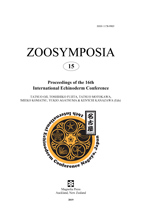Abstract
Cold seep deposits are characterized by authigenic carbonates with very low δ13C signatures and specific fossils of chemosynthetic community members. These members are mainly composed of mollusks, whereas only a few occurrences of fossil echinoderms from cold seep deposits have been reported. The information of paleoecology of fossil echinoderms in or near cold seep environments is also sporadic. Allochthonous columnal fossils of an Isocrinina crinoid species were found in a boulder of Cretaceous cold seep carbonate from the Yezo Group in northern Hokkaido. The stable carbon isotope of the fossil crinoid specimens showed very low values, approximately −30‰ (VPDB) or much lower value. The low δ13C signatures of the seep crinoids and their mode of occurrences suggest that the fossil crinoids lived near the seep environment, and they assimilated low δ13C organic particles shifted from there.

